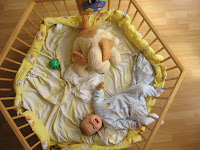Working on Das atmende Klarsein has provoked a bit of a crisis. Not that I can’t handle a piece for solo bass flute, small choir and live electronics. I eat that stuff for breakfast. Well, ok, I usually wait until after breakfast….
The crisis comes from several directions. One is historical. You wouldn’t think a contemporary music person like me would be faced with issues of historical performance practice, but it happens all the time. Styles change, techniques change, instruments are built differently, all with the rapidity of less than one generation. And I’m not even thinking about the electronic components!
I did not really like the piece at first. Take the first movement for flute: at first listening it is nothing more than a grab-bag of (now cliché) flute sounds: airy, elephantine honks on a piece of metal plumbing along with the rattling of ill-fitted key work. A real 1980’s museum piece. How on earth does one mould these sounds into something that can say something today? Was there even a “something” that needed to be moulded? My guess was yes. I have noticed a direct correlation: the more obscure something sounds you can bet the more heavy the philosophical component lurking behind the work. And it turns out I was right. At least that is somewhere to start! Research!
There is no lack of information regarding the background of this piece. The score is sold with a DVD for didactic purposes. OK. I’m undyingly grateful and informed. However, the audience will not have the benefit of this DVD, they may not even bother to read the program notes. I need to present something that sounds convincing without a brief lecture on the philosophical texts of Plato, Hölderlin, Walter Benjamin and Rilke. Is it just me, or am I strange in thinking one should be able to enjoy music on a purely sensual level?
That is crisis No. 1 in a nutshell. Crisis No. 2 is this: I’m having to eat my words. All my composer spanking has, in a way, come back as a great kick in the behind. Ok, some of you may be sniggering about that. Go ahead. You see, Nono was one of those great composers who really, really worked closely with the performer. This is what I’m always encouraging composers to do, telling them not to do this, not to do that, to be precise in notating what the player can do. Well it seems to me in this respect Nono was so successful that I see in the score what Roberto Fabbriciani could play, and in fact, I don’t know really what Nono himself wanted. I can only infer it by gathering background information on this piece and working with those who knew him. (So you see, oral tradition still plays a great role!) That is a grey area I can deal with, as I am experienced in interpreting and improvising. But it is an example where I wish the notation were a little, hmm, less precise and more open to variations of articulation, dynamics and sound color. As a matter of fact, I don’t feel as if I am playing a piece by Nono at all sometimes. Of course the overall concept of the piece is his, but when it comes to the flute part I feel less like I’m crawling into the skin of the composer and more like I’m crawling into the skin of Roberto Fabbriciani. Please note, I mean absolutely no disrespect here for the man!
However, Fabbriciani says in the DVD that the score is a point of departure for interpreters. Whew! The role of the bass flute is also explained: it represents a nostalgia for the future, as the choir represents a nostalgia for the past. I wonder if it is the same esthetic as his work for violin, tape and electronics, La Lontananza Nostalgica Utopica Futura? In any case I found this a useful concept. Nostalgia for the future also goes through it’s fashion, from Star Trek to Sun Ra’s cult film Space is the Place. The trick is to present sounds, phrasing and so on that sound fresh and forward-looking in today’s world.
I was reminded of a passage from Stanislavski’s book An Actor Prepares. The actor was to interpret the role of the hero who was a misogynist. The difficulty was, the piece was a light comedy, not a tragedy. What is funny about a misogyny? Analysing the role, the actor discovers that the hero does not really hate women, he only wants to project that image. That gives lots of scope for irony and self-deprecation. The parallel here is that I am reminded again not to take the written score at face value, but to find in it the voice I want to project.
Was I successful? Well, depends on who you ask. After the concert I was pleased to hear from some that they enjoyed the piece on a purely musical level, not knowing Nono’s music. Approval from the non-cognoscenti, so to speak. However, one Famous Flutist remarked that it was impressive, but had nothing to do with actual flute playing. I was disappointed that was how it came across, as if intonation, long-ass phrases and extreme control of the direction of air stream have nothing to do with flute playing. Although maybe it was a compliment in that the technical processes were well hidden enough so that at least something came out?
(edit) Here is a read-only share link to a later formal article that I co-authored with Daniel Agi concerning Nono’s late flute works.
https://soundcloud.com/sfem-1/luigi-nono-das-atmende


